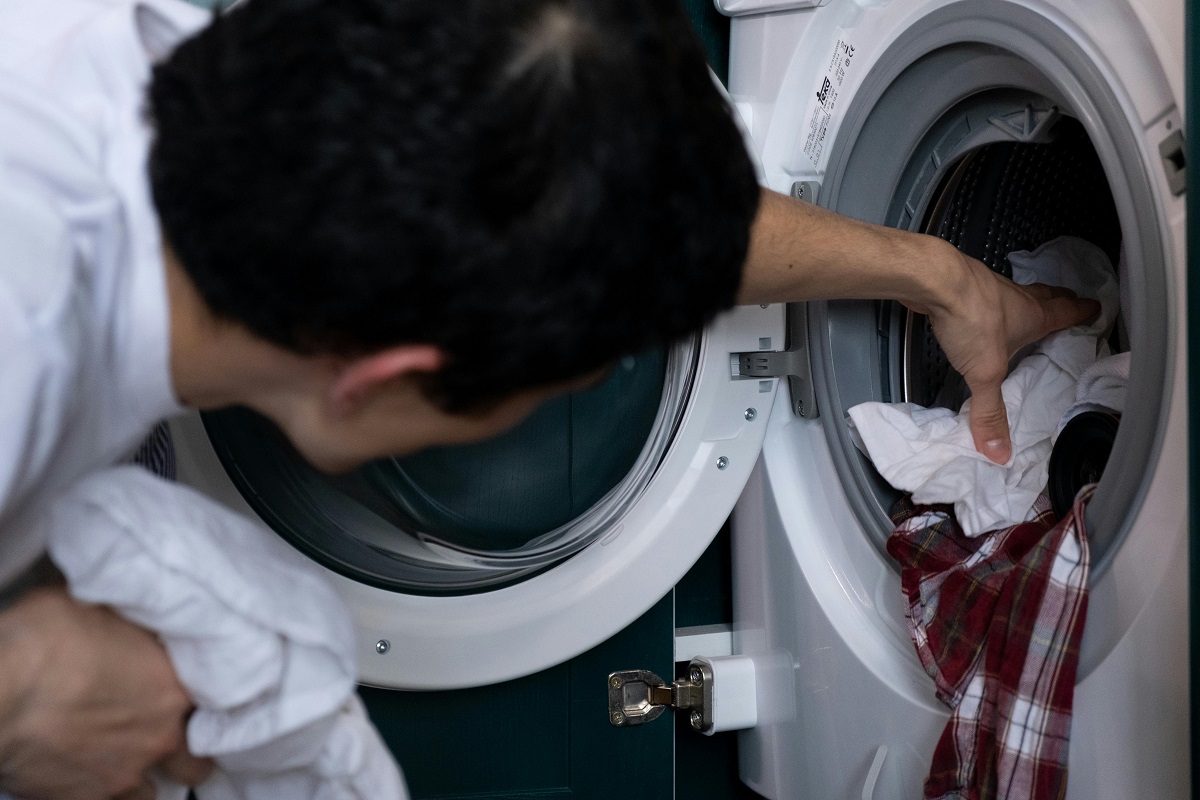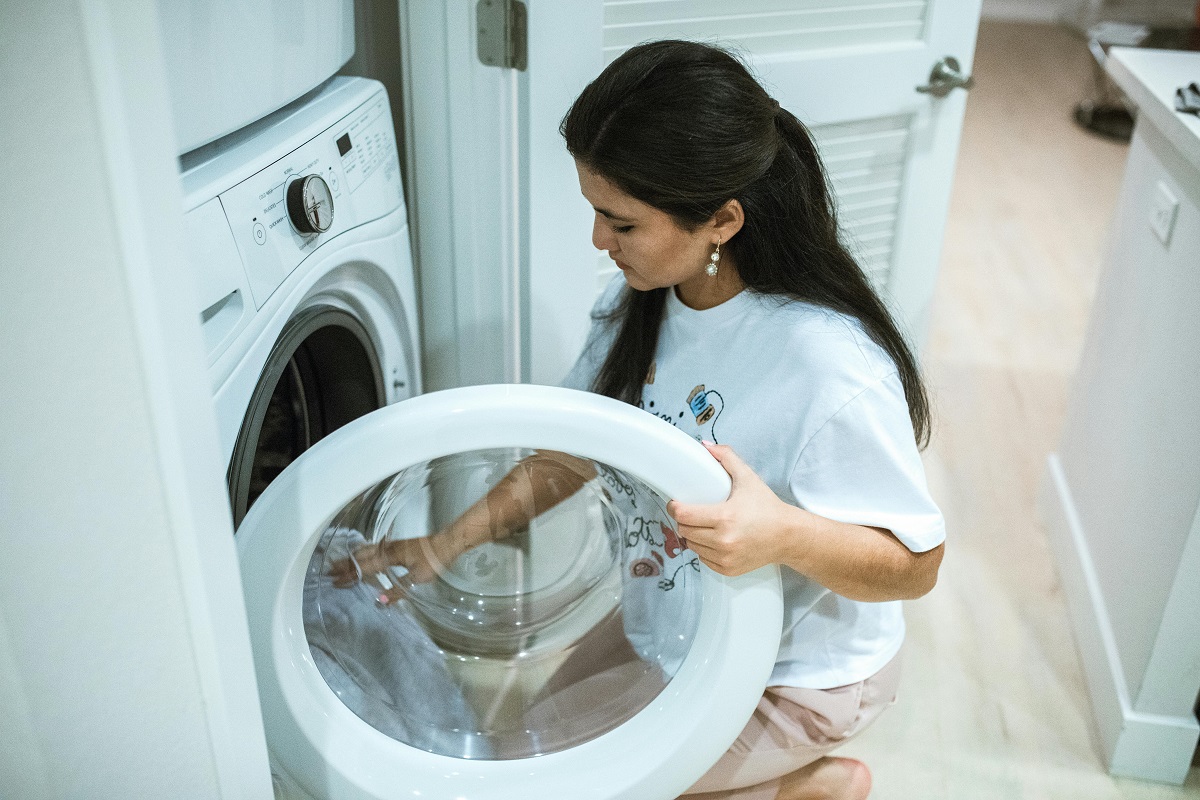- A washing machine that won’t spin or drain is usually caused by common issues such as clogged hoses, a faulty pump, lid switch problems, unbalanced loads, worn belts, motor issues, dirty filters, or control board malfunctions.
- Regular maintenance, including cleaning filters, inspecting hoses, and using the correct detergent, can prevent most spin and drain problems.
- Unbalanced loads or overloading the washer are frequent causes of incomplete cycles, and redistributing laundry can often fix the issue immediately.
- DIY troubleshooting is possible for many problems, such as clearing blockages, checking belts, testing the lid switch, or redistributing loads, but some repairs (motor, pump, or control board) may require professional help.
- A malfunctioning washer increases energy and water usage due to longer cycle times, reruns, and inefficient drying, which can drive up household utility bills.
- Scheduling professional maintenance annually helps detect worn parts, motor issues, or electronic problems before they cause costly breakdowns.
- Knowing when to replace the washing machine—after repeated repairs, old age, or rising energy bills—can save money and ensure reliable performance.
Few things are more frustrating than putting a load of laundry in your washing machine, only to realize it won’t spin or drain. Not only does this leave your clothes soaking wet, but it can also cause bigger issues down the line if ignored. Understanding why your washing machine won’t spin or drain—and knowing how to fix it—can save you time, money, and unnecessary stress.
In this guide, we’ll cover the most common causes, how to troubleshoot the problem, tips for DIY repairs, when to call a professional, and even how this problem can impact your energy bills.
Why Won’t My Washing Machine Spin or Drain?

When your washer fails to spin or drain, it’s often your machine trying to tell you something. There are several possible causes, ranging from minor issues to more serious mechanical failures.
Understanding why your washer stops spinning or draining is the first step to fixing the problem. Below, we break down the most common causes with detailed explanations and practical solutions.
1. Clogged or Kinked Drain Hose
A blocked drain hose is one of the most frequent reasons a washing machine won’t drain. Over time, hoses can accumulate lint, detergent residue, small objects, or even mold, which restricts water flow. Hoses may also get bent or kinked behind the machine, creating an obstruction.
Signs of a clogged hose:
- Water remains in the drum after the cycle finishes.
- Strange gurgling or bubbling noises during drainage.
- Partial spinning or incomplete cycles due to water being trapped.
How to fix it:
- Unplug the washing machine for safety.
- Detach the drain hose and check for visible blockages.
- Use a plumbing snake, flexible brush, or running water to clear the obstruction.
- Inspect the hose for cracks, splits, or kinks and replace if damaged.
- Ensure the hose is correctly positioned—avoid sharp bends or twists that restrict water flow.
Extra tip: Periodically running hot water and a small amount of vinegar through the hose can prevent buildup and odors.
2. Faulty Pump
The drain pump is responsible for moving water out of the drum during the drain cycle. If it fails, water stays trapped inside the washer. Pumps can fail due to wear and tear, foreign objects, or motor problems.
Signs of a bad pump:
- A humming or buzzing sound with no water movement.
- Water pooling at the bottom of the drum.
- The cycle ends prematurely or doesn’t progress to draining.
How to fix it:
- Unplug the washer and locate the pump, usually at the bottom of the machine.
- Check for debris like coins, buttons, or small clothing items blocking the impeller.
- Inspect the pump belt (if your model has one) for fraying or loosening.
- Test the pump motor with a multimeter if you have one.
- Replace the pump if cleaning or minor adjustments don’t resolve the issue.
Extra tip: Keep small objects out of pockets before washing to prevent future pump clogs.
3. Lid Switch Problems
Most washers are designed not to spin if the lid or door isn’t closed properly, as a safety measure. A faulty lid switch may prevent the spin cycle entirely, even if the lid appears closed.
How to check:
- Open and close the lid several times to see if the machine responds.
- Listen for a click when closing the lid, indicating the switch is engaged.
- Test the switch with a multimeter if you are comfortable with electronics.
- Replace the lid switch if faulty, following the manufacturer’s instructions.
Extra tip: On front-loading machines, check the door latch and seal as well—damaged latches can mimic lid switch problems.
4. Unbalanced Load
Washers detect uneven loads and may stop spinning to prevent damage to the motor or drum. Overloading or unevenly distributing heavy and light items is a common cause.
Tips to fix unbalanced loads:
- Remove some items if the washer is overloaded.
- Redistribute clothes evenly around the drum.
- Mix heavy items (like towels) with lighter items (like shirts) to maintain balance.
- Avoid washing a single heavy item alone, such as a blanket or rug, which can create extreme imbalance.
Extra tip: Some modern machines have a “drum redistribution” feature—pause and allow the washer to attempt balancing before forcing a spin.
5. Worn Drive Belt
The drive belt connects the motor to the drum, allowing it to spin. Over time, belts can stretch, slip, or break, preventing proper spinning.
Signs of a worn belt:
- Drum spins inconsistently or not at all.
- Squealing, grinding, or unusual noises during operation.
- Visible fraying, cracking, or slack in the belt.
How to fix it:
- Unplug the machine and access the belt according to the manufacturer’s guide.
- Remove the old belt and replace it with a new one of the correct size and type.
- Check the belt tension—too loose and it will slip, too tight and it may strain the motor.
Extra tip: Periodically inspect the belt as part of routine maintenance to catch wear before it causes a breakdown.
6. Motor Issues
The motor powers both spinning and draining. Motors can fail due to electrical problems, worn brushes, overheating, or mechanical failure.
What to look for:
- Burnt smells or smoke coming from the machine.
- Loud or unusual noises during cycles.
- Washer fails to start or stops mid-cycle.
What to do:
- Stop using the washer immediately to prevent further damage.
- Check that the motor isn’t clogged with debris.
- Call a professional for inspection or replacement if motor issues are suspected.
Extra tip: Regular maintenance, like cleaning vents and ensuring proper voltage, can prolong motor life.
7. Blocked or Dirty Filter
Filters trap lint, coins, small items, and debris to prevent them from reaching the pump or hoses. Over time, a clogged filter can prevent proper drainage.
How to clean the filter:
- Locate the filter, often at the front bottom of the washer.
- Remove the filter and rinse it under running water. Use a soft brush if needed.
- Reinstall the filter and test the machine with a small load.
Extra tip: Cleaning the filter every month or two can prevent many common drainage issues.
8. Issues with the Control Board or Timer
Modern washers rely on electronic control boards, while older models use mechanical timers. Malfunctions in these components can prevent spin or drain cycles from starting.
Signs of control board issues:
- Machine doesn’t respond to settings.
- Spin or drain cycles are inconsistent or skip altogether.
- Error codes or display malfunctions (on digital models).
Solution:
- Test the control board if you have the technical knowledge.
- Replace the board if it’s faulty, following the manufacturer’s instructions.
- Consult a professional for complex electronic issues.
Extra tip: Power surges or unplugging the machine improperly can sometimes cause temporary control board glitches—resetting the machine may solve minor issues.
How a Washing Machine That Won’t Spin or Drain Affects Your Energy Bills

A malfunctioning washer doesn’t just inconvenience you—it can also drive up your energy costs. Here’s how:
- Extra water usage: If your machine can’t drain properly, you may rerun cycles to try to get your clothes clean, using more water than normal.
- Longer cycle times: Partial spins or failed cycles require multiple attempts, extending the machine’s runtime.
- Inefficient drying: Wet clothes left from incomplete spins force your dryer to work harder, consuming more electricity.
- Potential leaks: Standing water can cause pumps to overwork or even damage the motor, leading to higher energy usage.
Fixing the spin or drain problem promptly can help maintain your washer’s energy efficiency and reduce unnecessary electricity and water bills.
Step-by-Step DIY Fixes
If you want to tackle the issue yourself, here are some steps you can take safely:
- Unplug the Washer: Always start by disconnecting the power.
- Inspect the Drain Hose: Look for kinks or clogs. Clean or straighten as needed.
- Check the Filter and Pump: Remove debris and test for blockages.
- Redistribute Laundry: Ensure the load is balanced before running a cycle.
- Test the Lid Switch: Make sure the machine registers that the door is closed.
- Examine the Belt: Look for signs of wear and replace if necessary.
- Run a Test Cycle: After adjustments, run a small load to see if the issue is resolved.
When Should You Call a Professional?
While many issues are DIY-friendly, some problems require professional attention:
- Persistent water not draining after clearing hoses and filters
- Motor or pump replacement beyond your skill level
- Electrical or control board malfunctions
- Repeated issues despite balanced loads and maintenance
Calling a technician early can prevent further damage and costly repairs.
Preventive Tips to Avoid Future Spin and Drain Problems
Prevention is always better than repair, especially when it comes to your washing machine. A few simple habits can help you avoid spin and drain issues, prolong the life of your washer, and even save on energy and water bills.
1. Don’t Overload the Washer
Overloading puts extra strain on the drum, motor, and belts, which can prevent proper spinning and draining. Always follow the manufacturer’s recommended load sizes.
Tips:
- Spread clothes evenly around the drum.
- Wash bulky items like blankets or comforters separately from smaller items.
- Avoid cramming too many heavy towels into one load.
2. Clean the Filter Regularly
Your washer’s filter traps lint, coins, and small debris to prevent clogs in the pump and hoses. A clogged filter can lead to water not draining properly.
Tips:
- Locate the filter—usually at the bottom front of your machine.
- Remove it every few weeks and rinse thoroughly under running water.
- Use a soft brush to remove stubborn debris.
- Reinstall properly before running the next cycle.
3. Check Hoses Periodically
Drain and inlet hoses can wear out, kink, or clog over time, which affects drainage and spinning.
Tips:
- Inspect hoses every 3–6 months for cracks, leaks, or bulges.
- Make sure hoses are not bent or pinched behind the machine.
- Replace hoses that show signs of wear or damage.
- Clean the inside of the hoses occasionally to prevent buildup.
4. Use the Right Detergent
Using too much detergent or the wrong type can cause excessive suds, which can clog hoses and pumps and affect spinning.
Tips:
- Use high-efficiency (HE) detergent for HE machines.
- Follow dosage instructions on the detergent label.
- Avoid using regular detergent in high-efficiency washers, as it produces too many suds.
5. Distribute Laundry Evenly
An unbalanced load is one of the most common reasons washers fail to spin. Unevenly distributed laundry can cause the drum to wobble and trigger safety mechanisms that stop spinning.
Tips:
- Mix large and small items in each load.
- Don’t wash a single heavy item alone—add a few smaller items to balance it.
- Pause the cycle and redistribute clothes if you notice excessive vibration or noise.
6. Schedule Professional Maintenance
Even with regular care, some components like belts, motors, and pumps require professional inspection. Annual maintenance can prevent small problems from turning into costly repairs.
Tips:
- Have a certified technician check belts, bearings, and the drain pump once a year.
- Ask the technician to test the motor and electronic controls.
- Schedule maintenance before heavy laundry seasons to avoid downtime.
Extra Tip: Keep the Washer Level
An uneven machine can cause spinning and drainage issues even with proper loads. Make sure the washer sits level on the floor and adjust the feet as needed.
How to Know If It’s Time to Replace Your Washing Machine
Sometimes, repair isn’t the most cost-effective option. Consider replacing your washer if:
- Repairs are frequent and costly
- The machine is over 10 years old
- Multiple major components have failed
- Energy bills have noticeably increased despite fixes
Modern machines are more energy-efficient, which can save money in the long run.
FAQs About Washing Machines That Won’t Spin or Drain
Q: Can I still use my washing machine if it won’t spin?
A: You can wash clothes with caution, but wet loads will need manual wringing or extra drying. Continuing to run cycles without addressing the issue may damage the machine.
Q: How long does it take to fix a clogged pump or hose?
A: Minor clogs can take 15–30 minutes to clear. More complex pump replacements may take 1–2 hours.
Q: Are some washing machines more prone to this issue?
A: Top-load machines are slightly more tolerant of unbalanced loads, while front-loaders may stop spinning more frequently when the load is uneven.
Q: Does the type of detergent matter?
A: Yes. High-efficiency (HE) washers require HE detergent. Using regular detergent in HE machines can cause excess suds, leading to spin and drain issues.
Final Thoughts
A washing machine that won’t spin or drain is frustrating, but most causes are identifiable and fixable. By understanding the common culprits—from clogged hoses to faulty pumps—and taking preventive measures, you can keep your washer running efficiently and avoid high energy bills. Remember, if a problem persists or involves electrical or motor issues, it’s best to call a professional.
Taking care of your washing machine ensures it continues to handle your laundry effectively while saving you time, money, and stress.


